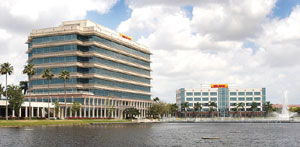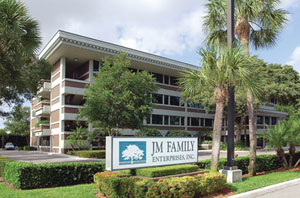ecently, Florida has become a convenient (and photogenic) poster child for America’s real estate market crash. However, this assessment is far removed from Florida’s contemporary economic reality – that of an increasingly diversified, three-quarter-trillion-dollar economy relying on multiple engines of growth.

In the past decade or so, Florida has grown beyond its traditional strengths like tourism and agriculture, emerging as an important center for knowledge-based industries such as biotechnology, IT, aerospace, motion pictures and professional services. It is a global hub for international trade, finance and transportation. This move toward a more diversified economic structure contributed to Florida’s resilience in the face of recent shocks such as 9/11, a nationwide recession and major hurricanes.
The emergence of these sectors of the economy, however, was exceeded by the explosive growth in the construction and real estate industries in the last few years. As looser credit conditions and financial innovation stimulated unusually strong demand for real estate worldwide, they raised home values and fueled an unprecedented boom in construction activity. In Florida, this resurgence of the housing sector temporarily overshadowed the state’s longer-term economic trends toward a more diversified economy.
From 2000 to 2006, Florida’s housing sector saw phenomenal growth: employment increased by over 40 percent, while output surged by over 80 percent. Housing went from accounting for 8.5 percent of total Florida employment to 10.5 percent over the same period. This exponential growth provided employment for unprecedented numbers of newcomers to the state and generated substantial government tax receipts, but it also distorted Florida’s overall economic structure. The dramatic increase in real estate prices also raised overall business costs and made housing less affordable for an increasing share of Florida’s work force.
Today, most of the U.S. (and many other developed economies) have seen a drastic slowing of their housing markets. In Florida, this has meant a gradual return of construction and real estate employment closer to pre-boom levels (which haven’t been reached yet). Other housing-related industries such as specialty retail and professional services as well as those directly affected by tighter credit conditions and shakier consumer confidence, such as finance, retail and auto sales, have also been losing employment. These job losses have dampened Florida’s overall labor market performance, and contributed to the misguided perception that “Florida is over.”
Contrary to perceptions fueled by the headlines, however, Florida’s once-torrid economy has continued to perform quite well. Behind the boom and bust of the housing sector, Florida’s “real” economy – which still accounts for 9 out of 10 jobs and more than three quarters of output in the state – has seen slower growth, but not an outright contraction.

Indeed, with the exception of housing and related industries, much of the rest of Florida’s economy is largely carrying on as before.
Economic growth in Florida presently has three key drivers, all cushioning the severity of the slowdown: international trade, tourism, and health care and education. Employment in health care and education has been growing consistently, posting a 27-percent increase since 2000 – double the statewide job growth for all industries. Likewise, employment in Florida’s tourism industry has increased by almost a fifth over the past eight years, and has been holding up quite well, even as record fuel prices are making travel less affordable.
Perhaps the brightest recent spot has been the performance of Florida’s international trade sector. Buoyed by robust economic growth abroad as well as favorable exchange rates, Florida’s exports are shattering all records and helping to sustain numerous high-skill jobs all over the state – particularly in the manufacturing sector, which employs over 365,000 Floridians. Over the past five years, Florida-origin exports (roughly speaking, goods “made in Florida”) have grown a third faster than total U.S. exports, increasing by 83 percent; so far this year, they are already running at levels 22 percent higher than a year ago. In fact, Florida trade may have played a pivotal role in limiting the severity of the economic downturn.
Florida’s economic performance is likely to remain below its long-term trends while the housing market is working off its recent excesses. Yet, behind the real estate ups and downs, Florida’s Innovation Economy is building momentum. In high tech industries ranging from life sciences and aviation and aerospace to photonics/optics, simulation and digital media, Florida companies continue to grow and prosper. The state’s universities are reaching new heights in research funding, patent generation and licensing income. Incubators across the state are bursting with spin-offs and start-ups while world-class research organizations are eager to tap into the brain power, friendly business climate and the next-generation infrastructure available here.
Indeed, just in the last year, Florida saw the arrival of Germany’s renowned Max Planck Institute and the formation of the Miami Institute for Human Genomics, which will add to its burgeoning life sciences cluster. Global innovation leaders in the aerospace industry, such as Embraer, Piper and Lockheed Martin are growing their Florida operations, fueled by a talented work force and strong support from the state.

In the diverse IT sector, developments in wireless, simulation and nanotechnologies are spurring the growth of a number of home-grown firms and attracting innovative companies such as FoxConn, Draper Fischer Labs and SRI International to the state.
Most recently, the clean energy sector – jump-started by the governor’s vision and commitment – is emerging as the new frontier in the diversification of Florida’s economy. The resulting flurry of activity ranges from the development of biofuels plants and support for ocean energy research to the expansion of entrepreneurial clean-tech companies and investments in clean energy infrastructure by the utilities. This growing industry is likely to create thousands of new high-wage jobs and help protect Florida’s enviable quality of life as well as its economic stability.
Clearly, Florida is in the midst of a major transition from its traditional economic drivers into a more diversified mix that includes a number of knowledge-based industries. The state’s economy is arguably more resilient today because of the efforts to grow its high-tech industries such as life sciences, aviation and aerospace, optics/photonics and clean energy. Florida’s leaders recognize that the state must continue to diversify and expand its economic drivers to ensure that in the future, Florida’s economy remains as dependable as its sunshine.